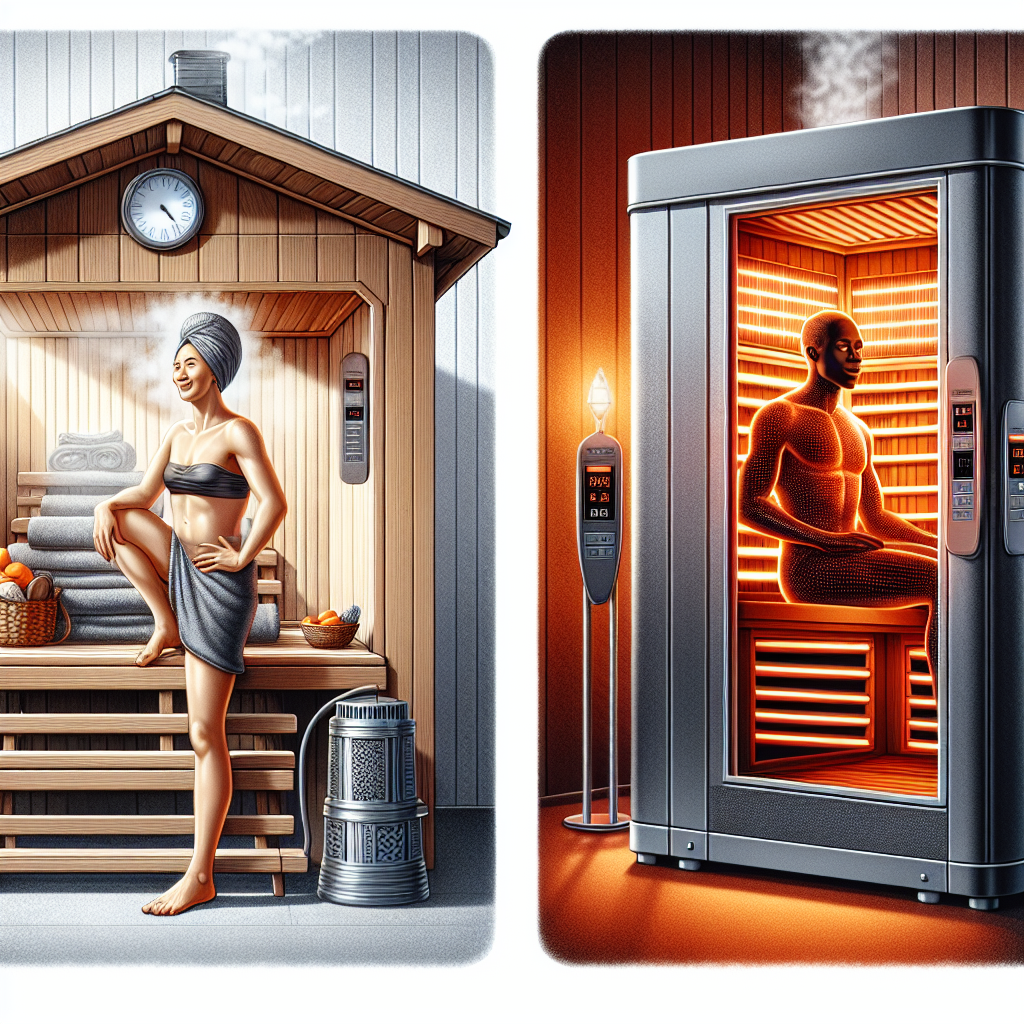Imagine stepping into a sauna, feeling the warmth encompass your body as you relax and unwind. But have you ever wondered about the difference between infrared saunas and traditional saunas? While both provide a rejuvenating experience, there are notable distinctions that set them apart. In this article, we will explore the unique characteristics and benefits of infrared saunas, shedding light on how they differ from their traditional counterparts. So, grab a towel and get ready to discover a world of wellness in this fascinating journey.
Heat Source
Infrared Saunas
Infrared saunas use infrared heaters to emit radiant heat. These heaters produce infrared rays which penetrate the skin and provide a gentle, yet effective heat source. Unlike traditional saunas, infrared saunas do not heat the air in the room directly. Instead, they heat the objects and bodies in the sauna, creating a warm and comfortable experience.
Traditional Saunas
Traditional saunas, on the other hand, rely on heated stones or electric heaters to generate heat. The stones or heaters are typically placed on a stove and water is poured over them to produce steam and increase the humidity in the room. This steam and hot air combination creates the traditional sauna experience.
Temperature
Infrared Saunas
Infrared saunas are known for their ability to deliver a more controlled and precise temperature. The temperature range in an infrared sauna usually varies between 110°F to 150°F (43°C to 66°C). These lower temperatures make infrared saunas more tolerable for longer sessions compared to traditional saunas.
Traditional Saunas
Traditional saunas can reach higher temperatures than infrared saunas, averaging between 150°F to 190°F (66°C to 88°C). The intense heat in traditional saunas can cause discomfort for some individuals, especially those who are not accustomed to high temperatures. It is important to consider personal preferences and health conditions when deciding on the desired sauna temperature.
Heating Time
Infrared Saunas
Infrared saunas have a faster heating time compared to traditional saunas. It usually takes around 10 to 20 minutes for an infrared sauna to reach its desired temperature. This quick heating time allows for a more convenient and efficient sauna experience, especially for those who are short on time.
Traditional Saunas
Traditional saunas usually take longer to heat up, often requiring 30 to 60 minutes to reach the desired temperature. This longer heating time may be a drawback for individuals who prefer immediate access to a sauna or do not have the patience to wait.
Operating Cost
Infrared Saunas
When it comes to operating costs, infrared saunas generally have an advantage over traditional saunas. Infrared saunas are more energy-efficient and consume less electricity. The use of infrared rays to directly heat the objects and bodies in the sauna requires less energy compared to heating the entire sauna chamber and the air within it.
Traditional Saunas
Traditional saunas tend to have higher operating costs due to their need to heat a larger space and maintain higher temperatures. The continuous heating of the sauna chamber and the air inside requires more energy consumption, resulting in higher electricity bills.
Construction Materials
Infrared Saunas
Infrared saunas are often made using materials such as cedar wood, hemlock, or basswood. These woods are known for their durability, resistance to heat, and ability to maintain a pleasant aroma even when exposed to high temperatures. The use of high-quality wood in infrared sauna construction adds to the overall aesthetic appeal of the sauna.
Traditional Saunas
Traditional saunas can be constructed using a variety of materials, including cedar, hemlock, pine, or even tile. The choice of construction materials for traditional saunas depends on personal preferences and budget. It is important to select materials that can withstand high temperatures and humidity levels to ensure the longevity of the sauna.
Convenience
Infrared Saunas
Infrared saunas are often considered more convenient than traditional saunas due to their quick heating time and compact size. They can be easily installed in homes or even smaller spaces, making them accessible to a wider range of individuals. Additionally, the low maintenance requirements of infrared saunas make them a hassle-free option for regular sauna use.
Traditional Saunas
Traditional saunas may require more planning and preparation due to their longer heating time and larger size. They are typically built as separate structures or take up a considerable amount of space in a house or gym. While traditional saunas offer a more traditional sauna experience, they may not be as accessible or practical for those with limited space or time constraints.
Air Quality
Infrared Saunas
Infrared saunas are well-known for their ability to provide a more comfortable and breathable environment. Since the infrared rays directly heat the objects and bodies in the sauna, the air inside remains relatively cooler and less humid. This can be beneficial for individuals who struggle with respiratory issues or find high humidity uncomfortable.
Traditional Saunas
Traditional saunas, especially those producing steam, can result in high humidity levels and a hot and stuffy atmosphere. While some individuals enjoy the intense heat and steam, others may find it difficult to breathe or feel uncomfortable in such conditions. It is important to consider personal preferences and any existing health conditions when choosing between a traditional sauna and an infrared sauna.
Health Benefits
Infrared Saunas
Both infrared saunas and traditional saunas offer numerous health benefits, but the specific benefits may vary. Infrared saunas are believed to provide deep detoxification by promoting sweating and eliminating toxins from the body. They can also help with stress reduction, relaxation, and improving circulation. Some individuals claim that regular use of infrared saunas can also support weight loss and enhance skin health.
Traditional Saunas
Traditional saunas are known for their ability to provide a more intense sweat and heat experience. They can help relax muscles, reduce stress, and improve blood circulation. The steam produced in traditional saunas is believed to have a soothing effect on the respiratory system and may provide temporary relief for congestion or cold symptoms. However, it is important to note that the health benefits of traditional saunas are subjective and may vary from person to person.
Detoxification
Infrared Saunas
Infrared saunas are often praised for their detoxification benefits. The deep penetration of infrared rays into the skin helps promote sweating and releases toxins from the body. Sweating is a natural way for the body to eliminate waste, and regular use of an infrared sauna can support this process, aiding in detoxification and cleansing.
Traditional Saunas
Traditional saunas also induce sweating, which can help eliminate toxins from the body. However, the intensity of sweating may not be as great as in infrared saunas due to the lower temperatures. The steam produced in traditional saunas can still have a cleansing effect on the skin and promote detoxification, although to a lesser degree than infrared saunas.
Effect on Skin
Infrared Saunas
Infrared saunas are commonly believed to have positive effects on the skin. The heat generated by the infrared rays can open up pores and increase blood circulation, resulting in a healthy and glowing complexion. Some individuals report improvements in acne, eczema, and other skin conditions after regular use of infrared saunas.
Traditional Saunas
Traditional saunas can also have beneficial effects on the skin, although the steam produced may cause temporary redness or irritation for some individuals. The heat and humidity in traditional saunas can help cleanse the skin by opening up pores and promoting sweat production. However, it is important to moisturize the skin properly after sauna use to prevent dryness or dehydration.
In conclusion, both infrared saunas and traditional saunas offer unique experiences and benefits. The choice between the two ultimately depends on personal preferences, health considerations, and the desired sauna experience. Infrared saunas provide a more controlled and comfortable heat source, while traditional saunas offer high temperatures and steam for a more intense sweat experience. Consider the factors discussed above and choose the sauna that best suits your needs and lifestyle for maximum enjoyment and health benefits.

